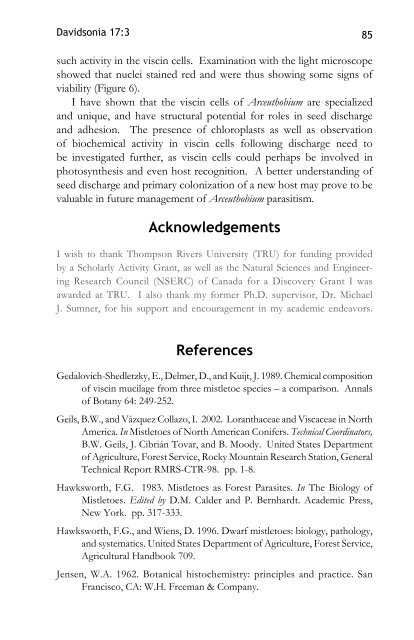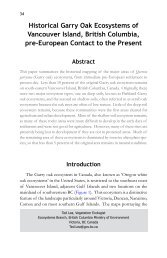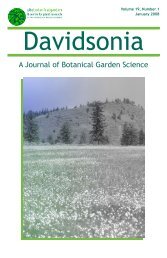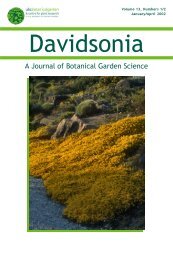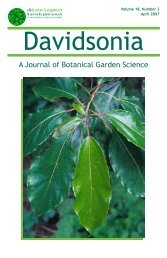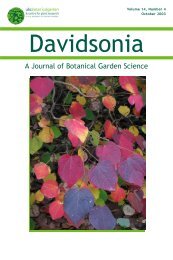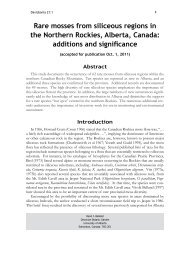Viscin Cells in the Dwarf Mistletoe Arceuthobium ... - Davidsonia
Viscin Cells in the Dwarf Mistletoe Arceuthobium ... - Davidsonia
Viscin Cells in the Dwarf Mistletoe Arceuthobium ... - Davidsonia
- No tags were found...
Create successful ePaper yourself
Turn your PDF publications into a flip-book with our unique Google optimized e-Paper software.
<strong>Davidsonia</strong> 17:3 85<br />
such activity <strong>in</strong> <strong>the</strong> visc<strong>in</strong> cells. Exam<strong>in</strong>ation with <strong>the</strong> light microscope<br />
showed that nuclei sta<strong>in</strong>ed red and were thus show<strong>in</strong>g some signs of<br />
viability (Figure 6).<br />
I have shown that <strong>the</strong> visc<strong>in</strong> cells of <strong>Arceuthobium</strong> are specialized<br />
and unique, and have structural potential for roles <strong>in</strong> seed discharge<br />
and adhesion. The presence of chloroplasts as well as observation<br />
of biochemical activity <strong>in</strong> visc<strong>in</strong> cells follow<strong>in</strong>g discharge need to<br />
be <strong>in</strong>vestigated fur<strong>the</strong>r, as visc<strong>in</strong> cells could perhaps be <strong>in</strong>volved <strong>in</strong><br />
photosyn<strong>the</strong>sis and even host recognition. A better understand<strong>in</strong>g of<br />
seed discharge and primary colonization of a new host may prove to be<br />
valuable <strong>in</strong> future management of <strong>Arceuthobium</strong> parasitism.<br />
Acknowledgements<br />
I wish to thank Thompson Rivers University (TRU) for fund<strong>in</strong>g provided<br />
by a Scholarly Activity Grant, as well as <strong>the</strong> Natural Sciences and Eng<strong>in</strong>eer<strong>in</strong>g<br />
Research Council (NSERC) of Canada for a Discovery Grant I was<br />
awarded at TRU. I also thank my former Ph.D. supervisor, Dr. Michael<br />
J. Sumner, for his support and encouragement <strong>in</strong> my academic endeavors.<br />
References<br />
Gedalovich-Shedletzky, E., Delmer, D., and Kuijt, J. 1989. Chemical composition<br />
of visc<strong>in</strong> mucilage from three mistletoe species – a comparison. Annals<br />
of Botany 64: 249-252.<br />
Geils, B.W., and Vázquez Collazo, I. 2002. Loranthaceae and Viscaceae <strong>in</strong> North<br />
America. In <strong>Mistletoe</strong>s of North American Conifers. Technical Coord<strong>in</strong>ators,<br />
B.W. Geils, J. Cibrián Tovar, and B. Moody. United States Department<br />
of Agriculture, Forest Service, Rocky Mounta<strong>in</strong> Research Station, General<br />
Technical Report RMRS-CTR-98. pp. 1-8.<br />
Hawksworth, F.G. 1983. <strong>Mistletoe</strong>s as Forest Parasites. In The Biology of<br />
<strong>Mistletoe</strong>s. Edited by D.M. Calder and P. Bernhardt. Academic Press,<br />
New York. pp. 317-333.<br />
Hawksworth, F.G., and Wiens, D. 1996. <strong>Dwarf</strong> mistletoes: biology, pathology,<br />
and systematics. United States Department of Agriculture, Forest Service,<br />
Agricultural Handbook 709.<br />
Jensen, W.A. 1962. Botanical histochemistry: pr<strong>in</strong>ciples and practice. San<br />
Francisco, CA: W.H. Freeman & Company.


